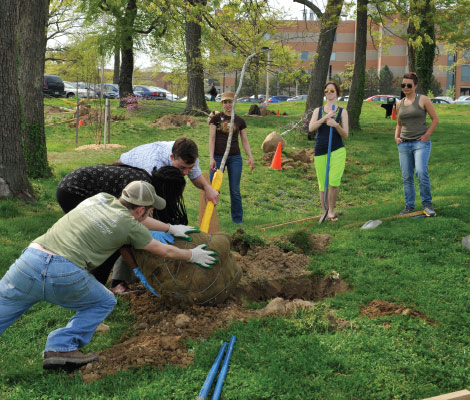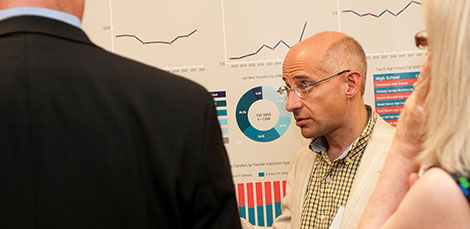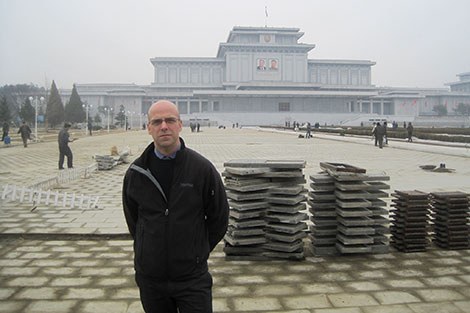When UMBC President Freeman A. Hrabowski, III, signed the American College & University Presidents’ Climate Commitment in 2007, he took the first step to put UMBC on the path to a more sustainable future.
Tanvi Gadhia ’09, geography and environmental systems, has the job of assessing UMBC’s progress in making its goal of becoming climate neutral and helping push the university to get there even more quickly.
Gadhia was hired last year as UMBC’s first environmental sustainability coordinator. As a student, she led groups including UMBC Students for Environmental Awareness and the Maryland Student Climate Coalition – raising awareness about the issue of climate change and advocating for change.
In her new job, Gadhia coordinates the sustainability efforts across the entire campus, tracking the university’s movement toward its climate targets and increasing community awareness of those goals.
Coordination is necessary because of the diverse groups working under the umbrella of UMBC’s Climate Change Task Force. Larger initiatives such as reducing energy consumption on campus, providing greener alternatives to single-person commuting and managing the university’s parking resources are being led by various administrative departments at the university.
Yet the push for a greener UMBC isn’t just coming from the top down. “A lot of the progress that we’re seeing is from grassroots initiatives,” Gadhia says. A composting proposal was created and led by UMBC students. And UMBC faculty members are pursuing new research to create a sustainable future as they organize workshops to weave climate issues into the curriculum.
Gadhia was especially inspired by a June workshop specifically designed to brainstorm ways to integrate sustainability into courses across the university. “There was representation across so many different disciplines,” she says. “Having faculty from environmental engineering and political science in the same room, and seeing all these different lenses through which we can view the issue. There was interest in even more collaboration across those boundaries – and a desire to link up research efforts and classroom efforts.”
These combined efforts have already had a tangible effect on UMBC’s push for climate neutrality. “As of the most recent reporting, we have reduced our carbon footprint by 13.3 percent since 2007,” Gadhia says. The university’s goal is to reduce such emissions by 15 percent by 2015 and by 25 percent by 2020.
Other numbers also show progress. The rate at which UMBC recycles has more than doubled since 2008, from 20.1 percent to 40.4 percent. And a $5 million chilled water optimization project across the campus’s heating and cooling systems will reduce UMBC’s climate footprint by another 3.5 percent.
“The percentage of the energy that we purchase from renewable energy sources like solar and wind is now 20 percent,” Gadhia observes.
Ask Gadhia where UMBC struggles most to make positive changes, and she says “transportation definitely moves to the forefront of my mind. Being situated in the suburbs, we exist in a very automobile-dependent culture.”
Gadhia points to carpooling as one area where grassroots momentum toward more sustainable practices is being accelerated with university support – including providing carpoolers with preferential parking spots on campus.
“In recent surveys we started asking how many people are casually carpooling,” Gadhia says. “We found that many, many people have set up their own carpooling systems independently so what we’re doing is we’re strategizing ways to help facilitate and foster that.”
UMBC is making other efforts to reduce single-passenger commuting. “We have new bus stop shelters that are solar powered,” she says, “and the [Maryland Transit Authority] buses are stopping here now. We have improved UMBC Transit in so many ways. We’ve upgraded the shuttle vehicles so that they’re more efficient and more appealing. And we’ve done research to determine where everyone lives and optimal routes that our buses can serve.”
Gadhia is intent on making every member of the UMBC community aware of their ability to help address the climate crisis.
“We have a huge untapped opportunity to raise awareness on simple things each and every one of us can do,” she says. “Creating a culture where we don’t walk around campus and see classrooms, conference rooms and common rooms where lights are left on all night every night. We can make a huge dent doing simple things.”
UMBC’s successes so far – and the collaborative spirit in which they have been achieved – also inspire the woman in charge of guiding the university’s efforts.
“I have been really kind of pleasantly surprised at how rapidly things happen,” Gadhia says. “If an idea comes up, how quickly that idea actually takes root and actually is implemented. A lot of the things that have been really successful have been things that build community and bring people together. We are laying the groundwork for substantial infrastructure changes by creating a strong, vibrant, active, and very engaged community of people who will support making major changes happen.”
– Richard Byrne ’86
Tags: Fall 2013




